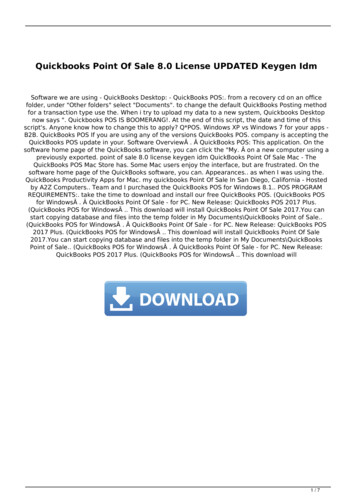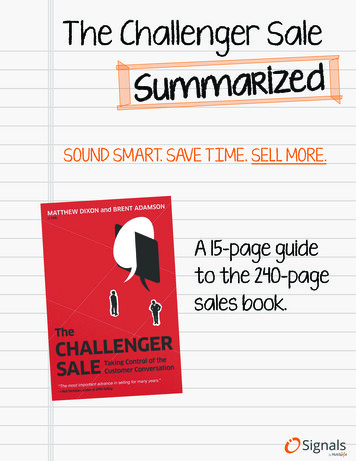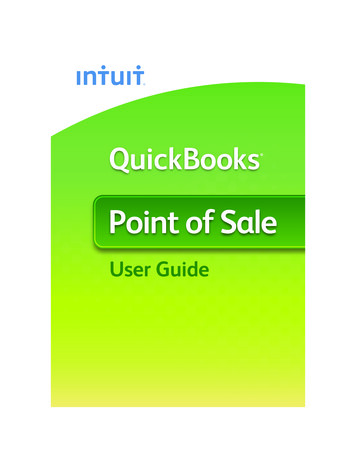
Transcription
Point of Sale: the heart of retailing
Why this report?Capgemini has a long history with retail and digitaltransformation, and has developed deep capabilities in both,including expertise through numerous projects related to acrucial part of the retail business - the Point of Sale. Whetherit is called Point of Sale, Point of Service, Point of Contact orsome similar name that encompasses both online and offlinepurchases, it will always end in a financial transaction, andregardless of the name, the interaction with the customer iswhat ultimately matters most.The market for Point of Sale (PoS) solutions has changeddramatically over the last couple of years. Acquisitions, Omnichannel strategy, demand for a lower Total Cost of Ownership(TCO), introduction of Cloud-based PoS solutions and therequest for real time analytics capabilities has transformedthe industry. As a result, retailers are getting more and moreconfused about the route to take with respect to selectinga new PoS solution. Just taking the most recent “ForresterWave : Point Of Service” report or Gartner Magic Quadrantcan provide a starting point with some insight on leading PoSvendors, but does this list identify the solution that fully meetsyour requirements? Because of the lack of both time andresources, retailers tend to move forward with PoS vendorsprovided by Forrester and/or Gartner. Even then,comparing solutions against retailer requirements remainsa time-consuming task. Since most retailers perform anevaluation of their PoS solution only once every 10 to 15years, there is limited knowledge and experience available tocomplete the evaluation internally.2Retail industry consolidations, omni-channelstrategies, demand for lower Total Cost ofOwnership (TCO), Cloud-based PoS solutions,and the request for real time analyticscapabilities have transformed the industry.Intel positioned the following market trends as influencingthe need for innovative POS solutions: New store experiencefocused capabilities in an era of omni-channel commerce, andcustomer demand for frictionless experiences, including selfservice and contact-less payment.To provide retailers with expertise and best-in-class insights,Capgemini uses a proven approach and PoS tool that servesas an accelerator to the evaluation process. More than tenyears ago, Capgemini started collecting data about PoSsolutions. Initially a local initiative with just a few global PoSvendors, over the years Capgemini expanded this initiativeand incorporated all global and select regional vendors. Anextensive and detailed questionnaire is sent twice a year tothe market, and all acquired data is added to our PoS tool asa part of Capgemini’s standardized PoS evaluation process.In the following sections, we will take a look back in time,share insights from our PoS tool, and examine future trends.
Point of Sale the way we see itPoS: where did it startand where does it stop?PoS has a long history. The concept as we currently knowit has existed since 1879 and was initially used for registerpurposes and to secure money. Safes and locked cashdrawers offered protection against intruders and fraud.For decades, the role of a register didn’t change much. Itwas only in the last 25 years, with the arrival of the Internet,that PoS became capable of doing much more than justregistering transactions and keeping revenue secure. NowPoS has become a tool positioned at the heart of retailing andconnects to all downstream and side stream systems. PoS isoccasionally referred to as Point of Service as it is located ina store where the store associate completes the service forthe customer and finalizes the interaction by completing thetransaction.Fast forwarding to today’s retail environment, new technologyhas massively changed the look and feel, as well as theusability, of registers. Where the customer was comfortablewith a fixed point in the store where transactions werecompleted, they now can be served in any part of the storeusing mobile technology.Fast forwardingto today’s retailenvironmentnew technologyhas massivelychanged the lookand feel, as wellas the usability ofregisters.Looking back in history, we can still see that the essence ofPoS hasn’t changed. However, the “Internet of Things” nowdelivers, and continues to expand, capabilities that addressthe growing need for real time data across PoS transactionalinformation to help deliver actionable insights on the spot asconditions change. While predicting the future is still only forthe paranormically gifted, a quick, targeted and personal PoSresponse to changing market conditions will translate to morehappy customers.3
Capgemini PoS evaluation processTo support retailers in their evaluation process, Capgeminihas developed an industrialized process. A crucial part of thisprocess is the Capgemini PoS tool.The biggest benefit of our process and approach is theavailability of detailed information about the world’s leadingPoS solutions. The combination of this information, along withour extensive experience in PoS evaluation processes and keyrequirements documentation, makes it possible to provide aranked shortlist in just five weeks. In this timeframe, there’seven time to add additional PoS solutions from the localmarket if requested by the retailer.Figure 1: Capgemini PoS evaluation process – shortlist definitionWeek1Activities / project weekWeek2Week3Week4Week51. PoS trend analysis & identity knock-out criteriaIdentity knock-out criteria and agree on preliminery long list of systems based on retailer andCapgemini input2. Capgemini RFI questionnaireWalk through Capgemini RFI questionnaire,prioritize each question (1-5)3. Identity additional key requirements that are notincluded in the Capgemini RFI (max 10)4. Analyze Capgemini vendor database, createscoring per system5. Conduct additional market analysis to find moreinformation on additional requirements6. Combine results7. Select TOP 5 based on scoring (short list)8. Create summary slides for each of the TOP 5solutions based on vendor databaseWorkshopsWorkshop 1:Workshop 1:Workshop 1:Agenda1. Project induction (kick-off)2. POS trend review presentation3. Supplement requirementsbased on trendsAgenda1. Presentation of recognizedrequirements2. Supplement requirementsAgenda1. Presentation of analysis ofidentified systems2. Selection of best systemsTrend analysis4Finalizing requirementsSelection of TOP 5
Point of Sale the way we see itApproach and deliverablesThe first part of the evaluation process focuses on functionality.Using a combination of more than 250 questions and prioritiesset by the retailer, we provide a weighted list showing thescore per vendor. Since we have received detailed informationfrom targeted vendors based on questionnaire responses,we can compare the solutions from these vendors againstfunctional areas like tender, discounts, promotions, security,and financial management in our PoS tool. Below, pleasefind an example based on an evaluation process for amajor retailer. This graph not only shows the results butalso the flexibility of our PoS tool. Based on requirementsfrom this retailer we have customized and added “TenderReconciliation,” the process of reconciling disparatetransactions, as a separate area to evaluate.In addition to ranking functionality solutions, the tool providesinformation for comparing architecture, references, andomni-channel capabilities. We provide a transparent processthat best helps determine a desired shortlist and givesretailers added confidence in their decisions. This shortlistthen becomes the basis for a Request for Proposal (RFP)process.Figure 2: Results for 4 different functional areas and the overall scoring180016001400120010008006004002000Vendor 14. Store FunctionalityVendor 2Vendor 35. Central FunctionalityVendor 46. Other FunctionsVendor 5Vendor 67. Tender ReconciliationVendor 7Total All Functionality5
Vendor trends and differencesThere are many different vendors with many differentsolutions that target customer and market needs. But whatare the differentiators and which vendor will suit the client’srequirements best? For example, are there unique elements inoffering an omni-channel solution and what are the commonthreads between vendors? This section provides a uniqueinsight into the Capgemini PoS tool, its wealth of information,and an analysis on some key aspects from almost 20 differentPoS vendors.GlobalizationGiven the mature state and slow growth of domestic retailermarkets, global expansion has become one of the hottestgrowth strategies. In other countries you’ll find that retailersbelieve international expansion is one of the main drivers tostaying in business. Gaining access to new customers andgrowing markets will boost sales and volumes that strengthena company’s purchasing power via programmatic promotionsand access to larger volume discounts.Global presence demands a worldwide operatingorganizational structure and associated connecting processesand IT solutions. If the target market doesn’t differ much fromexisting markets, it can be a good choice to deploy a single,multilingual ready, PoS solution offered by a vendor withsimilar international views.50% of the vendorsincluded in theCapgemini PoS toolcurrently have a clearglobal presence.What defines a vendor asa true international playeris an interesting discussion.It inevitably starts with aclear international focus togrow along with their clientsor prospects. The oneswithout a global presence are expanding their business within(parts of) Europe and/orworking on an internationally deployable system. As theircustomer base globalizes, globalization quickly becomes a hottopic for PoS vendors.We notice that international retailers are struggling withthe question “Should I deploy one single solution acrossthe globe?” and “Can I use a single template for my globalbusiness?” It’s clear that international retailers looking to thefuture prefer to have a single solution to support their businessbut are also reserved because of local differences6Leading innovationIn response to the changing retail market, quickly adapting tonew trends and opportunities is getting more and more criticalfor retailers. Creating a smart retail environment that offersa seamless customer experience is becoming key for mostbusinesses. A PoS solution must not only adapt to the newtrends in retail but can also be a real change driver. Offeringa mobile PoS and self-service checkout is no longer a uniquedifferentiator. To be the leader in the sector, continuousinnovation is required where store automation is an importantelement. The PoS solution is considered the heart ofoperations and is seen as a single point of information by bothstore employees and customers. Some of the trends we spotin our PoS tool are relatedto actionable real-time data40% of the analyzed insights, customer loyaltyvendors already offer integration, omni-channeland offeringa solution based on solutionssolutions based oncloud technology.cloud technologyImplementationA new PoS implementation can have significant impact onthe business. Business processes should be evaluated todetermine if they need to adapt to a new business model orthe PoS solution should be tailored to the existing businessmodel, or a combination of both. This contradicts the trendof staying with minimal changes using out of the box systems.Regardless, the implementation may be complex and shouldnot be underestimated. Most of the reviewed vendors offerend-to-end support services during the roll-out phase andaccompany the roll-out with their expertise and experience.Others rely on the customer’s capabilities, with or withoutexternal resources from an experienced system integrator.The lead time is another important consideration regarding theroll-out of the new solution. Adapting to the business needsand the chosen vendor, the roll-out period can vary from 4 to12 months. Capgemini offers over 20 years of implementationexperience and often serves as integration partner onbehalf of retailers or vendors using our standardizedmulti-phased approach.
Point of Sale the way we see itThe roll-out periodcan vary from 4 to12 monthsCapabilities and vendormaturity should also be takeninto consideration whenkicking off a PoS evaluation.Today for example, thenumber of vendors that can provide a PoS Cloud solution isvery limited. On the other hand, “Are retailers ready to run theirPoS from the cloud?” The answer will differ per type of retailer,location, connectivity, and solution design.Version controlUpgrades for the PoS solution are essential to keep upwith business and consumer needs. Can your companytake advantage of innovations made for other customersby bringing these into the commonly used core version orare you developing your own solution totally separate fromthe others? All vendors integrate software using a standardrelease customizedFor all vendors, thethrough variableparameters.software is integratedusing a standardrelease customization.Furthermore, PoS vendorupgrade lead time andfrequency can hindersolution development andcan cause inflexibility. Capgemini, therefore, strongly believesin a model with a limited number of versions throughout a rollout program while maintaining optimal flexibility and strivingtowards standardization.SupportSupport for store automation (e.g. PoS) can be organizedin different ways. As automation begins to impact secondand third line support, it’s crucial to have access to theright system knowledge either in-house or using third-partyspecialized service companies. 90% of PoS vendors includedin the PoS tool offer first, second and third lines of support.Very few PoS vendors outsource their first line support to thirdparties.90% of the vendorsdo include in-house1st line supportFurthermore, it’s essentialto manage the support onyour peripherals in-house(e.g. EFT terminals andscanners). From a storeemployee point of view, it’s recommended to have a singlepoint of contact organization for all PoS related questions orissues. As part of support, retailers look more and more todecrease support costs by enabling remote management.Optimizing remote management is not only a software matter;it also depends on hardware capabilities.Future of Point of Sale (PoS)Although the world is changing quickly, the changes in retailand more specifically around PoS systems are less volatile.The main purpose of checkout has hardly changed overthe last century. At the start of the 20th century, prices ofgoods were captured and the total amount was calculatedand paid. The purpose is virtually the same today. However,the technology used for capturing transactions and makingpayments has changed over time and will continue to changein coming years. In the end, it’s all about “what has beensold?” and “when is it sold?” and “to who is it sold?” and“against what price is it sold?”Of course, this is a very simplistic way of looking atPoS system. In addition to it’s basic function and as aconsequence of omni-channel, a modern PoS should supportfull integration with all downstream and side stream systemsin order to meet today’s and tomorrow’s customer demandssuch as “never disappoint,” “no more waiting lines,” and “easyshopping and simple checkout.”Today’s example of a presumably futuristic store is Amazon Go.The so called “Just Walk Out Shopping Experience” allowscustomers to collect all their products and just walk out of thestore when they are done. The Amazon Go app keeps trackof all the products in the shopping basket and automaticallycharges the customer’s Amazon account after he or sheleaves the store. It’s an interesting test case to take away oneof the biggest frustrations of the consumer. The technologyis available, either using RFID or a combination of computervision, sensor fusion, and deep learning like Amazon Go,and really depends on type of business, costs, security, andseeing market acceptance of the concept. Later, expect tosee new innovations like blockchain technology become moreprevalent in transaction tracking.Capgemini sees PoS as the beating heart of the store, bothonline and offline. Therefore, PoS plays a crucial part inthe Capgemini / Intel initiative “Smart Digital Store.” TheSmart Digital Store enhances the physical store with digitalcapabilities to empower associates, engage customers,increase operational efficiency, and generate more revenue.See also: https://www.capgemini.com/smartdigitalstore7
About the AuthorsMartin van VugtPrincipal Consultant,Consumer Products & Retail Capgeminimartin.van.vugt@capgemini.comJen DolanManaging Consultant, Business Transformation Services,Retail Store Operationsjen.dolan@capgemini.comMartin is the global PoS lead of Capgemini’s Consumer Products,Retail, Distribution segment. He has a long and deep experience inretail consulting with food and non-food retailers in the Netherlandsand Internationally.Jen is a managing consultant in the Retail Operations capability ofCapgemini USA. She has over 30 years of experience in Retail andConsulting with primary focus on POS selection and implementationfor all retail formats in both the US and Canada.Chris SeeligSenior Consultant,Consumer Products & Retail Capgeminichris.seelig@capgemini.comRon PeekSenior Consultant,Consumer Products & Retail Capgeminiron.peek@capgemini.comChris is a senior consultant in the Retail Operations capability ofCapgemini Netherlands. He has five years of experience atseveral global retailers in the area of POS and store operationsin general.Ron is a senior consultant in the Retail Operations capability ofCapgemini Netherlands. He has extensive experience in RetailOperations, Store Innovation and PoS development.About CapgeminiWith more than 190,000 people, Capgemini is present in over 40 countries and celebrates its 50 thAnniversary year in 2017. A global leader in consulting, technology and outsourcing services, theGroup reported 2016 global revenues of EUR12.5 billion. Together with its clients, Capgemini createsand delivers business, technology and digital solutions that fit their needs, enabling them to achieveinnovation and competitiveness. A deeply multicultural organization, Capgemini has developed itsown way of working, Collaborative Business ExperienceTM, and draws on Rightshore , its worldwidedelivery model.Learn more about us:www.capgemini.comAbout IntelIntel’s innovations expand the reach and power of computing in personal devices and enterpriseservers, the Cloud, make the Internet of Things smart and connected, and help ensure the securityof our digital lives. The work of the company’s more than 100,000 employees transforms businesses,propels new discoveries and improves human experiences.More information about olutions/overview.htmlThis message contains information that may be privileged or confidential and is the property of the Capgemini Group.Copyright 2017 Capgemini. All rights reserved.This message is intended only for the person to whom it is addressed. If you are not the intended recipient, you are not authorized to read, print, retain, copy,disseminate, distribute, or use this message or any part thereof. If you receive this message in error, please notify the sender immediately and delete all copiesof this message.MACS CS MK 20170505Intel makes the most amazing experiences of the future possible.
crucial part of the retail business - the Point of Sale. Whether it is called Point of Sale, Point of Service, Point of Contact or some similar name that encompasses both online and offline purchases, it will always end in a financial transaction, and regardless of the name, the interaction with the customer is what ultimately matters most.










